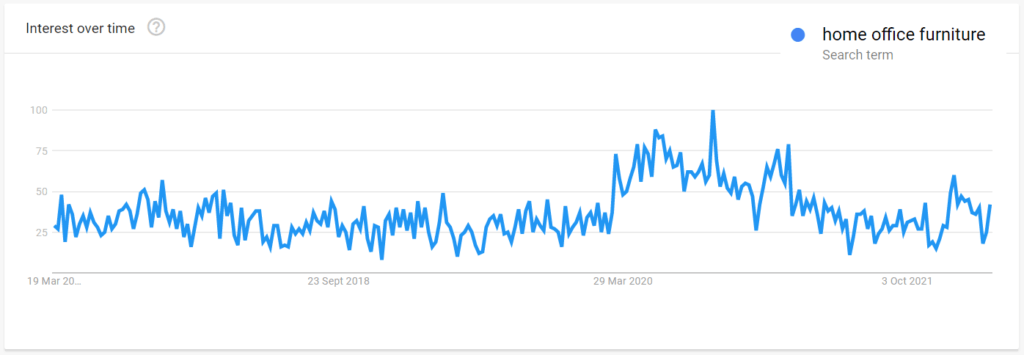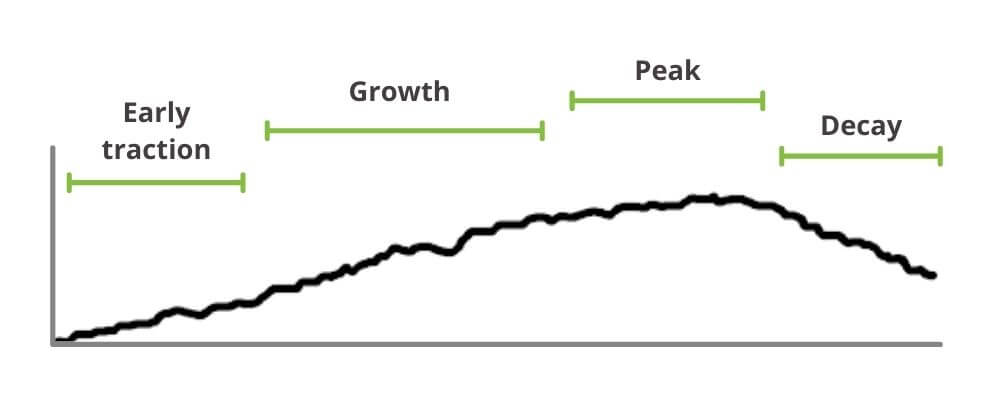Content Decay: How to Recover Lost Traffic and Build a Moat Around Your Content
When devising a content strategy for your business, it’s tempting to focus on just creating new content. But by ignoring the content that already exists on your site, you’re missing out on a big opportunity to gain more traffic.
The hard truth is that no piece of content will perform well forever. Google updates their algorithms, the intent behind keywords shifts and information quickly goes out of date. As a result, your content can decay over time after an initial period of growth.
As your traffic plateaus and declines, you might write this content off as a lost cause. However, there are many things you can do to recover this traffic – or, even better, trigger a new phase of growth.
Updating old content is like buying from a second hand shop. You go in, poke around to see what old items have potential, then give them a new lease of life. In fact, you can add even more value than there was before.
Content decay is something you can easily incorporate into your content audits, workflows and processes. In this guide, you’ll learn what content decay is, how to identify decaying pages and tactics to improve them.
We’ll also cover how to build a protective ‘moat’ around your content, so you can prevent significant traffic loss in the future. This way, your content strategy will be both reactive and future-proof.
What is Content Decay?
Content decay is when the performance of your content starts to decline. It can refer to a loss in organic traffic, rankings or conversions. Typically, this occurs after an initial period of growth, which plateaus and then begins to drop over time.
This decline can be sudden or gradual, and can happen for a range of complex reasons.
What Causes Content Decay?
There’s rarely one concrete reason why your content is decaying. Most of the time, a number of factors are at play.
Before you make any changes, it’s important to understand what’s causing it. This means you’ll be able to create a more informed action plan.
Here are a few questions to ask yourself:
Have My Competitors Published a New Piece of Content?
A competitor publishing a better piece of content than you is a common reason why decay happens.
Google your target keyword and see who’s ranking above you. What do they do differently? Is their content more comprehensive or original? Do they cover additional topics that you don’t?
Is My Content ‘Fresh’ Enough?
Google rewards pages that reflect the current expert consensus in your niche.
If you published a blog post giving medical advice 10 years ago, the treatment for the disease may have changed.
In their Quality Rater Guidelines, Google mentions that high-quality pages must provide accurate, up-to-date information.
As a result, they prioritise pages in the SERP (search engine results page) that provide the best information for the user’s query right now – not 10 years ago.
Check the information in your blog posts: are you providing the freshest information available? Or has the conversation moved on?
The word ‘fresh’ also refers to when the page was published. If your page went live five years ago, Google may prioritise a newer page instead.
Has There Been a Google Algorithm Change?
The issue may not be with the content itself, but your website more broadly.
Google releases Core Updates multiple times per year. These can have site-wide implications that cause your rankings and traffic to drop.
Investigate these issues further if you’re seeing drops across the board.
Are People Still Searching for the Topic?
Sometimes, there’s nothing wrong with your content or website.
Instead, your traffic decline is because fewer people are searching for your topic.
Google Trends is a really useful tool to help diagnose this problem. It can show you whether keywords are decreasing in popularity.
For example, some keywords – like ‘home office furniture’ – exploded in popularity when more people worked from home. Now, as people return to offices, this topic is becoming less popular.

No matter how great your content is, the search demand could’ve just dried up.
Has the SERP Changed?
Google regularly adds new SERP features.
For example, videos appear for some search queries, like ‘how to’ keywords that require a demonstration.
Your content may still be ranking well, but Google has decided to display videos for the query now. These videos could be stealing clicks away from your page.
Similarly, a ‘Featured Snippet’ – where Google adds a quick summary at the top of the SERP, without the user having to click a result – could be harming your click-through rate.
Google your target keywords to see whether this could be having an impact.
Do I Have a Cannibalisation Issue?
Cannibalisation is where multiple pages on one website compete for the same keyword, and Google can’t work out which one to prioritise. As a result, neither page ranks well in search engines.
Type “site:[your domain] + [keyword]” into Google to view which pages are ranking the highest for this query.
Are there multiple pages targeting the same phrase? If so, this may be the cause of your content decay.
Now you understand why content decays, it’s time to identify pages on your website to improve.
How to Identify Decaying Content
Here are three ways you can spot content that’s entering the ‘decay’ stage of its lifecycle:
1. Google Analytics
Go to Google Analytics → Behaviour → Landing Pages and add an ‘Organic Traffic’ segment. This will show you which of your pages are attracting organic users and sessions.
Set the date range to the last 6 or 12 months so you have enough data to work with.
Individually click on the top performing results. What does the growth curve look like? Is it increasing, plateauing or decreasing?
This is what a decaying traffic curve looks like:

This can be quite a time-consuming process if you have a lot of pages to check, so prioritise those with the most traffic first.
2. Revive
Revive is a tool from content marketing agency Animalz.
All you need to do is add your domain, and you’ll get a custom report with pages on your site that are decaying.
This takes some of the leg work out of manually checking URLs on Google Analytics. It’s a great starting point before you investigate these pages further.
3. SEO Monitor
SEO Monitor is a paid tool, but contains lots of unique insights to help you spot content opportunities.
You can track the performance of individual keywords (and the associated pages) and identify any that are decreasing in rankings or traffic. You can also see search volume trends for keywords with YoY comparisons.
SEO Monitor is great for identifying cannibalisation issues too. It’ll flag if the landing page has changed frequently for your chosen keyword, which is a telltale sign that Google is confused about which page to prioritise.
At this stage, you should have a list of pages that are decaying. Below are some ideas to put them back on an upward trajectory.
4 Ways to Refresh Decaying Content
Give your content a spring clean with these four methods:
1. Update
Naturally, facts and statistics become less relevant over time.
According to Google’s Quality Rater Guidelines, having content that reflects a “well-established expert consensus” is critical.
As a result, after a few years (or even a few months), your content may already be out of date.
This is also important because what people are looking for might’ve changed over time.
For example, if you work in the education sector, there may have been a large change to the school curriculum. That means that any content that reflects the old curriculum is no longer relevant.
When people land on your page, they’ll be frustrated if the information isn’t up to scratch.
To fix this, go back through decaying content, fact check any statistics and information, and update it accordingly. Where possible, link out to external sources to make the content more reliable and trustworthy.
2. Add More Content
Adding more content is another way to recover lost traffic.
By this, we don’t mean increasing the word count for the sake of it. It’s not about adding on an extra few hundred words that provide no additional value.
Instead, look for gaps in your content. Is there something your competitor has covered that you haven’t?
You can also use tools like Answer the Public to find commonly searched questions about your topic.
Even better, are there additional topics that no one has covered at all? This is a great way to stand out and cover ground no one else has.
Aim to add more depth and breadth, rather than saying the same thing in a new way.
3. Review Keyword Targeting
Have you optimised your page effectively? For example, have you included your keywords (and natural variations) in your metadata, headings and body content?
If not, go ahead and optimise these elements further.
Another thing you can do is check your page in Google Search Console. What are you currently ranking for? Are there any surprises?
If there are terms there you haven’t optimised for, but you already rank for them, this is a good opportunity to focus your copy around these queries. This is a quick win to boost them further up the SERPs.
As we mentioned earlier, it may be the case that your keywords are declining in search volume.
If so, do some additional keyword research to see if you can find some alternatives that are still popular. Then, target these terms instead to shift the focus towards what users are interested in.
4. Merge Multiple Posts Together
Do you have multiple pages that cover the same topic? If so, it may be worth merging them together, rather than having two similar pages on your site.
This will mean the remaining post will be more comprehensive. It can also resolve any issues with cannibalisation that could be holding you back.
Don’t rush into this. It’s important to think strategically about where you want the content to end up.
Check in Google Analytics and/or Google Search Console to see which of the similar pages perform the best. Choose the best performing page to keep, and merge the other posts with this.
When merging the posts together, make sure the content doesn’t repeat itself. Cut out any parts that answer the same questions, but keep in elements that add more depth and breadth.
Once you’ve merged the content on one page, delete the old page and set up a permanent redirect.
This is by no means an exhaustive list, but provides a good starting point for refreshing your content.
This is all well and good, but is there any way to future-proof your content moving forwards, so decay doesn’t happen again?
We covered all of these tips, and more, in our Beyond Content Creation webinar! Fill out the form below to watch it on-demand:
How to Build a Moat Around Your Content
Whilst there’s no sure-fire way to prevent content decay, there are things you can do to keep it at bay.
We like to think of this as creating a protective ‘moat’ around your content.
How can you create content that’s hard for someone else to replicate? A page that has strong foundations and won’t be knocked down the SERP by your competitors?
Original Research and Data
One way to prevent content decay is by including original research and data. For example, you could run a survey or leverage internal data that no one else has.
This will enhance your content and make it more unique, as you’re not just including statistics – you’re the source of them, too.
Not only that, it can attract backlinks if you have a strong enough news ‘hook’.
Linkable content like this will further cement your position in the SERPs, because links can improve your rankings if they’re relevant and high quality.
New Format
When you Google your target keyword, what kinds of content dominate the top positions? Are they mostly blogs and text-based informational pages?
Think of ways to provide a unique experience for the user. For example, you could make content that’s interactive, or include multimedia elements like infographics and videos.
Ask yourself: what’s the best way I can present this information to give the user what they’re looking for?
If your content’s format is unique, it’s more likely to perform well – as long as you’re still matching the user intent.
Thought Leadership
Many SERPs are dominated by blog posts recycling the same information over and over.
One way you can stand out is by offering a strong opinion. You’ll need to assess this on a case by case basis, and ensure any opinions reflect those of your brand. But it’s a powerful way to stand out.
If thought leadership isn’t right for you, having a unique perspective can work well too.
What point of view are you coming from? How is this different from the pages already in the SERP? Lean into what makes you unique to differentiate yourself from the competition.
This kind of content can also attract backlinks, because people will cite you if you’re saying something original or persuasive.
By now, you should have a list of decaying pages on your site and some ideas for how to improve them. But this isn’t a one-time job, so how can you incorporate dealing with content decay into your workflow and processes?
How to Adapt Your Content Processes
Content marketing processes shouldn’t just be about creating new content. Instead, you should balance this with updating old content too.
There’s no magic formula to this. You’ll have to conduct a thorough audit to work out which posts need updating, how often, then include this in your editorial calendar.
You can easily create a spreadsheet with tabs for pages you need to update, merge, delete and any pages that will need to be reviewed on a regular basis.
Some businesses will spend 50% of their time on new content, and 50% updating existing content. This all depends on how much content you already have and how it’s performing.
Perhaps you want to audit your content every quarter or yearly. Decide this as part of your content strategy and mark it in your calendar to complete ahead of time.
Final Thoughts
Marketers like to say that ‘Content is King’, but no monarch lasts forever.
Increased competition, algorithm updates and changes in user behaviour can all dethrone your page from a top spot in the SERPs.
But if you create a moat around your content and nurture it over time, it’ll stay ahead of the competition and perform better for longer.
Need help updating your old content?
The SEO Works have an experienced team of content writers who can help you make the most of your existing pages.
Get in touch to discuss our content marketing and SEO services.

(They/Them)
Liam is an SEO Team Leader with a background in journalism. They’re passionate about E-A-T, ethical SEO and devising content strategies that get clients results.

